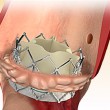The relative benefits and risks of off-pump coronary artery bypass grafting (CABG) as compared with the use of CBP are not clearly defined. The CORONARY trial in 79 centers randomized 4,752 patients in whom CABG was planned with or without CBP. There was no significant difference in the primary end point which was a composite...
CABG vs. PCI for LM Disease: do we Need a New Randomized Trial?. The Rationale for EXCEL Trial
Alfredo E. Rodriguez 2012-08-10
PCI vs. CABG in patients aged under 50 years
Original title: Comparison of 30-Day and 5-Year Outcomes of Percutaneous Coronary Intervention Versus Coronary Bypass Grafting in Patients Aged ≤50 Years. Reference: Fausto Biancari, et al. Am J Cardiology Article in Press. Coronary artery bypass grafting (CABG) is associated with better evolution than percutaneous coronary intervention (PCI), mainly due to left main and multiple vessels re...
PCI with everolimus eluting stent or CABG for multivessel coronary artery disease.
Original title: Everolimus-Eluting Stents or Bypass Surgery for Multivessel Coronary Disease. Reference: Sripal Bangalore, M.D. et al. N Engl J Med. 2015 Mar 26;372(13):1213-22. Coronary artery bypass grafting (CABG) have had better outcomes than percutaneous coronary intervention (PCI) in the treatment of multivessel coronary disease. However, this information comes from studies that do not include new generation stents....
Off-Pump CABG Reduces Postoperative Stroke vs. Standard Surgery
Reference: Afilalo J, RAsti M, Ohayon SM, et al. Off-pump vs on-pump coronary artery bypass surgery: an updated meta-analysis and meta-reggresion of randomized trials. Eur Heart J 2011. Epub ahead of print. Patients who undergo off-pump coronary artery bypass grafting (CABG) surgery experience nearly one-third fewer postoperative strokes than those who receive standard surgery using cardiopulmonary...
2 Year Outcomes of Transcatheter Mitral Valve Replacement with Intrepid
Severe mitral valve insufficiency (MI) has been associated to the progressive deterioration of left ventricular function, cardiac and kidney failure, and increased mortality. Complete medical treatment at maximal doses and surgery are indicated. For those at high risk or those with ventricular function deterioration, edge-to-edge repair has been shown an excellent alternative. The use of...
Invasive Correlation (CFR – IMR) with Coronary Slow Flow
Prior registries have shown that 65% of patients with chronic coronary syndrome (CSS) and angina do not present obstructive atherosclerosis. This phenomenon, called myocardial ischemia with no obstructive coronary arteries (INOCA) is more common in women and has been associated with high hospitalization costs and diminished quality of life. INOCA patients can present microvascular dysfunction...
Glycemic Control and Coronary Stent Failure
Diabetic patients have twice as high a risk of developing coronary artery disease (CAD). Additionally, CAD increases mortality risk. Patients with a history of percutaneous coronary intervention (PCI) tend to need repeat revascularization, even with second generation stents. To date, there are few studies assessing the role of glycemic control in stent failure, stent thrombosis,...
Coronary Angioplasty with Sirolimus Eluting Stents
At present, most percutaneous coronary intervention procedures (PCI) are done with drug eluting stents (DES). However, drug coated balloons (DCB) have shown benefits in restenosis and small vessel de novo lesions. Intravascular ultrasound (IVUS) has been shown effective in left main PCI and complex procedures, even though there is little infomration on its use for...







